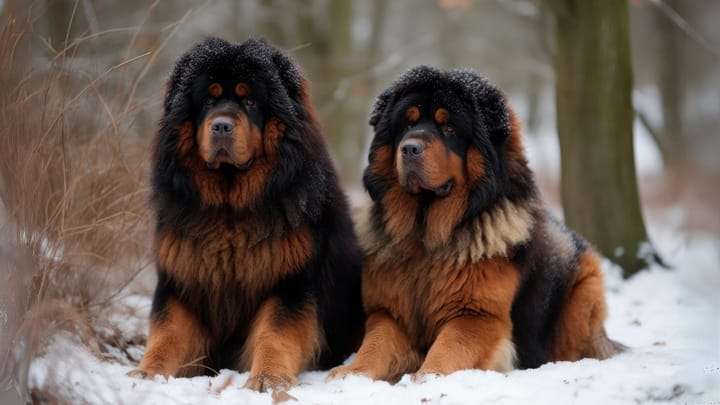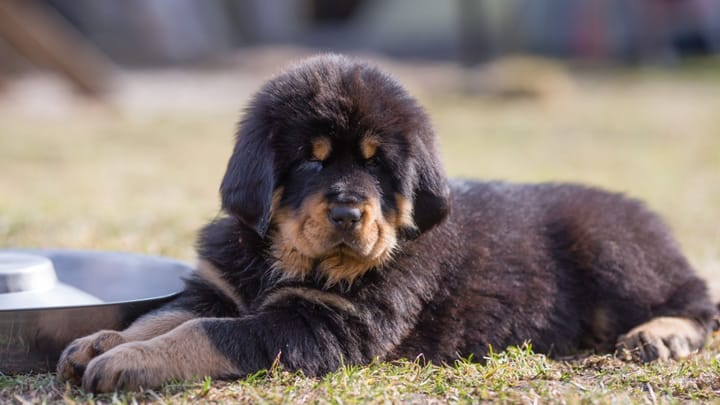Tibetan Mastiff
Other names : Drog-Khyi, Tsang-khyi


The Tibetan Mastiff is an excellent watchdog. Very attached to his owners without necessarily showing it, his priority is to protect all of his family and his territory. He is unpredictable, and can become aggressive if he deems it necessary. Being as strong and independent as he is, he is not suitable for everyone. Cohabitating with children or the elderly is not advised. Primitive, robust and powerful, he stands out of the lot and requires time to get to know. He needs to be accepted for what he is for the master-dog relationship to be harmonious and respectful.
|
Life expectancy |
The Tibetan Mastiff has a life expectancy of between 10 and 12 years |
|
Temperament |
|
|
Size |
Large
|
|
Adult size |
Female
Between 24 and 27 in
Male
Between 26 and 28 in
|
|
Adult weight |
Female
Between 121 and 176 lb
Male
Between 121 and 176 lb
|
|
Coat colour
The Tibetan Mastiff’s coat can be:
A little white mark (star-shaped) on the chest is admissible as well as subtle white patching on the paws. |
Black Sand |
|
Type of coat
The coat is long. The coat is thin but coarse, straight, thick and more abundant in males than in females. In the winter, a dense and wooly undercoat helps the dog brave the cold. The coat should neither be silky, curly nor wavy. On the neck and on the shoulder, the coat is abundant and forms a nice mane. |
Long Hard |
|
Eye colour
The eyes are a brown colour, of any possible shade and depending on the animal’s coat. Darker hues are more common. |
Brown
|
|
Purchase price |
The Tibetan Mastiff costs between £1000 and £1350 |
There are not many specimens in Europe, and he is practically extinct in Tibet, mainly on account of the effort it takes to maintain such a large dog. The current, main source of breeding is actually the UK.
One particularity is that- as is the case of many primitive breeds- the females are only in heat once a year, as opposed to twice a year in the case of breeds that have been more interfered with by Man.
More details about the Tibetan Mastiff
Tibetan Mastiff: Origins and history
The Tibetan Mastiff, also known as the Drog-Khyi, is a very ancient breed that used to work at the side of Himalayan mountain nomads, and was the Tibetan monasteries’ designated watchdog. Left practically intact over the centuries, he is a direct descendant of the ancient Tibetan Mastiff from which practically all other, currently known Mastiffs, molossians and molossoids sprang. He was once even bigger than he is now. Marco Polo described him as follows: “As big as a donkey, with a voice as powerful as that of a lion”.
Physical characteristics of the Tibetan Mastiff
The Tibetan Mastiff is a potent dog, of massive bone structure. The head is large and very imposing, the muzzle typical of a Mastiff but lighter than that of the English Mastiff, for instance. The eyes are medium-sized. The ears, pendant, are medium-sized, heart-shaped, smooth, close to the cheeks and turned forward when the dog is alert. The limbs are perfectly straight and strong. The tail is imposing, set high and curled over the back- very thick and feathered: covered in long and abundant hair.
Tibetan Mastiff: Characteristics
Tibetan Mastiff: Behaviour
Training a Tibetan Mastiff
It is not easy to train the Tibetan Mastiff, on account of his ample independence and his very assertive character. The training process must be precocious, firm and coherent.
Resorting to any kind of coercion will quickly end in failure with this powerful dog, who will not tolerate any brutality. What’s more, it would in fact be dangerous to apply coercive methods to this Tibetan ‘lion dog’, as it would only serve to tease his aggression out.
His strong character must be softened from his youngest years, through a quality habituation towards various environments, persons, and animals.
You must brace yourself and be patient, as this dog attains full maturity only very late.
Last but not least, you shouldn’t place your bets on making this dog ‘a champion of obedience’- he is indeed capable of learning and respecting certain rules of conduct and disciplinary basics, but remains an independent and unpredictable dog.
Tibetan Mastiff: Lifestyle
Breed compatibility Tibetan Mastiff
Tibetan Mastiff: Purchase price
The price of a Tibetan Mastiff varies depending on its origins, age, and sex. You have to count an average of £1350 for dogs registered at the Kennel Club.
Moreover, a ‘giant’ dog implies a ‘giant’ budget- with regards to the monthly budget required to meet the needs of a dog this size, you have to estimate an average of £70 per month.
Tibetan Mastiff: Shedding
Average
This Tibetan dog is subject to two moulting seasons a year, during which brushes must be daily in order to eliminate any residual dead hairs.
Tibetan Mastiff: Grooming
Despite being abundant, the Tibetan Mastiff’s coat is by no means difficult in maintaining, but must be tended to regularly nonetheless. Weekly brushes will be needed to preserve its aesthetic and protective properties.
Tibetan Mastiff: Health
Life expectancy is 11 years on average.
This dog is robust, and very resilient but does not, unfortunately, enjoy a particularly long life.
His impressive fur coat protects him from the cold, and also to some extent from the heat, but high temperatures are not the intended climate for him. In the summer, it is important to take him out on walks only once it’s cooled down, and to let him take refuge from the heat inside the house.
His double coat and solid constitution do equip him with a resistance to cold and rain without a problem. The Tibetan Mastiff actually prefers to sleep outside rather than inside, even during the winter.
Given that this mountain dog is not the biggest of athletes, it is important not to overfeed him, to prevent any risk of obesity.
- Epilepsy
- Demodicosis
- Ocular anomalies
- Hip dysplasia






